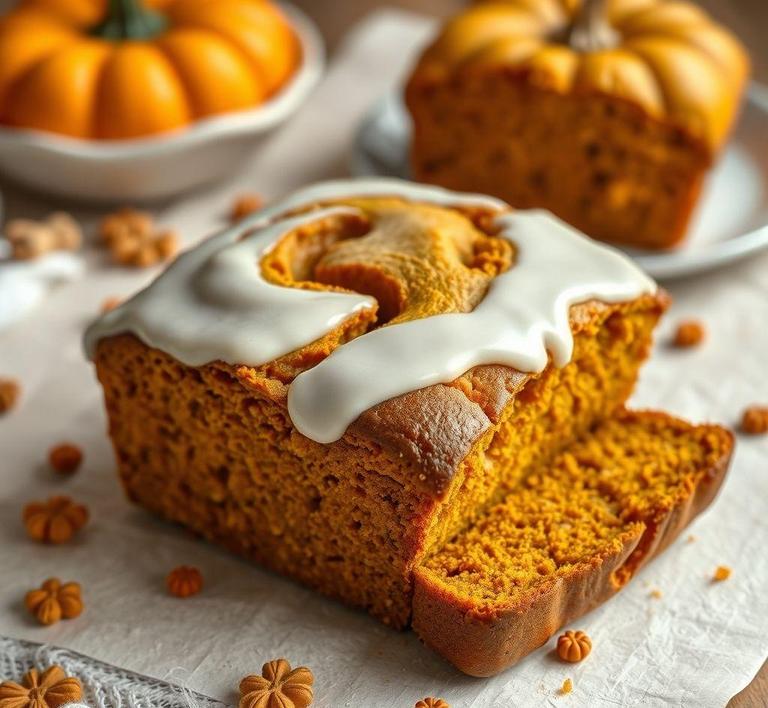If you’ve ever made a big batch of pumpkin bread and found yourself with more than you can eat, you might be wondering if you can refreeze it to enjoy later. The good news is, yes, you can absolutely refreeze pumpkin bread! This delicious fall treat can be preserved and enjoyed at a later date without losing its rich, spiced flavor or moist texture. In this guide, we’ll walk you through everything you need to know about refreezing pumpkin bread the right way, so you can savor it for weeks or even months after baking!
Can You Refreeze Pumpkin Bread?

When it comes to storing baked goods like pumpkin bread, there’s always a question of whether it’s safe or even advisable to refreeze them after they’ve been thawed. Pumpkin bread, with its moist texture and rich spices, is a popular fall treat that many people bake in batches to enjoy throughout the season. However, what happens when you’ve stored some of it in the freezer, taken it out to thaw, and then realized you won’t finish it all? Can you refreeze it without compromising the quality or safety?
The short answer is yes, you can refreeze pumpkin bread, but there are some important considerations to keep in mind. Refreezing pumpkin bread is technically safe as long as the bread was initially frozen properly and hasn’t been left out at room temperature for an extended period. However, the real question is whether it’s a good idea in terms of quality, which brings us to the next section.
How To Refreeze Pumpkin Bread?
If you’ve decided to go ahead and refreeze your pumpkin bread, there are some steps to follow to ensure it stays as fresh as possible.
- Check the Current Condition of the Bread: If the pumpkin bread has been left out at room temperature for more than two hours, it’s best not to refreeze it, as bacteria can develop, and it might no longer be safe to eat. If the bread was stored in the fridge or thawed under controlled conditions (e.g., in the fridge or on the counter for only a short period), then it should be safe to refreeze.
- Wrap the Bread Properly: To avoid freezer burn and preserve its texture, wrap the pumpkin bread tightly in plastic wrap or aluminum foil. You can also place it in a resealable freezer bag or an airtight container. Make sure to press out any excess air from the bag to prevent moisture from accumulating and leading to ice crystals that will impact the quality.
- Label and Date: Always label your freezer bags or containers with the date you’re refreezing the bread. This helps you keep track of how long it’s been stored and ensures you use it within a reasonable time frame (ideally within 2-3 months for best quality).
- Freeze Quickly: When placing your wrapped pumpkin bread back into the freezer, try to freeze it as quickly as possible. This minimizes the chances of ice crystals forming on the surface and preserves the bread’s texture and flavor.
- Thawing the Refrozen Bread: When you’re ready to enjoy the refrozen bread, it’s best to thaw it in the refrigerator overnight or on the countertop for a few hours, depending on your preference. Avoid microwaving it directly from the freezer, as this can make the texture rubbery and dry. If you’re in a hurry, a low-temperature oven (around 300°F) can gently warm it up without sacrificing too much of the original texture.
Quality Impact
While refreezing pumpkin bread is safe, the quality may suffer with each cycle of freezing and thawing. Here’s a closer look at how the quality can be impacted:
- Texture: One of the most significant impacts of refreezing pumpkin bread is the potential loss of its original moist texture. Pumpkin bread is often made with a high moisture content, which helps it stay soft and tender. When frozen, the water molecules in the bread form ice crystals, and when thawed, the moisture can be lost, leading to a drier loaf. Refreezing accelerates this process as the ice crystals continue to grow with each cycle, further damaging the bread’s texture.
- Flavor: Refrozen pumpkin bread may also experience a slight degradation in flavor. While the spices like cinnamon, nutmeg, and clove should still be noticeable, the freshness of the bread can diminish after being frozen and thawed multiple times. The bread may lose some of the depth of flavor and might taste slightly bland or flat.
- Crumb Quality: The crumb of the pumpkin bread, which refers to the inner texture, may also change after refreezing. You may notice that the loaf becomes more crumbly, with a less cohesive structure, which can make it more prone to falling apart when sliced.
- Moisture Distribution: Another aspect to consider is how moisture is redistributed during the freezing and thawing process. Freezing causes water to separate out in the form of ice crystals, and as these melt, some of the moisture might not be evenly reabsorbed. This can create soggy or uneven patches in the bread after it’s thawed and refrozen.
- Freezer Burn: If pumpkin bread is not wrapped tightly enough or if it’s stored too long, it may develop freezer burn. Freezer burn occurs when moisture from the bread evaporates and leaves behind dry, crusty patches, which can make it unpleasant to eat. These dry areas may also impact the flavor, making the bread taste stale.
While it’s entirely possible to refreeze pumpkin bread, it’s important to be aware of the impact on its quality. Refreezing can affect the texture, moisture, flavor, and overall freshness of the bread. The first time you freeze pumpkin bread will likely give you the best results, but with careful wrapping and proper storage, you can extend its shelf life for a few additional months.
For optimal results, avoid thawing and refreezing pumpkin bread more than once. If you have leftover bread, consider using it for other recipes, like pumpkin bread pudding or a decadent French toast, to make sure it doesn’t go to waste. While the taste and texture may not be the same as fresh-baked, refrozen pumpkin bread can still be a convenient and delicious option for later enjoyment, especially if you’re careful in how you handle the freezing and thawing process.
Is It Safe To Refreeze Pumpkin Bread?
Refreezing pumpkin bread is a topic that has sparked much debate, primarily due to concerns over texture, taste, and food safety. Technically, it is possible to refreeze pumpkin bread, but whether it’s safe or advisable depends on how it was initially frozen and how the bread has been handled during the thawing and refreezing process.
When you freeze pumpkin bread, the moisture inside the loaf is preserved, which helps to maintain its flavor and texture. However, when you thaw it, the bread can lose some of that moisture, resulting in a slightly drier loaf. Refreezing it after it’s been thawed will cause the bread to lose even more moisture, making it potentially crumbly, tough, or unappetizing in terms of texture. The bread may still be safe to eat from a food safety perspective, as long as it’s been properly handled, but you may not be as happy with the end result.
If you’re considering refreezing pumpkin bread, you need to take extra precautions. For instance, if the bread has been left at room temperature for more than two hours after thawing, it should not be refrozen, as bacteria can start to develop at that stage, making the bread unsafe to eat. Freezing it at the peak of freshness and thawing it slowly in the fridge can reduce the risk of degrading both flavor and safety.
Signs That Pumpkin Bread Should Not Be Refrozen
While pumpkin bread, like most baked goods, can technically be refrozen, there are certain red flags to look out for that indicate it should not be.
- Visible Mold or Spoiling: This is the most obvious sign that the bread should not be refrozen. If you notice any mold, discoloration, or unusual odors, the bread has begun to spoil. Refreezing will not reverse the effects of spoilage and could lead to foodborne illness.
- Improper Storage: If the pumpkin bread was not stored properly before being frozen-such as being wrapped in plastic wrap that wasn’t airtight or frozen in a container that allowed air exposure-it may have already begun to lose quality. Any signs of freezer burn, such as dry patches or ice crystals forming on the surface, suggest that the bread has lost moisture and quality, making it unappealing even if it’s refrozen.
- Thawed Too Long at Room Temperature: If the bread has been sitting out at room temperature for too long after being thawed-more than 2 hours-there is a significant risk of bacterial growth. Refreezing the bread after this will not kill bacteria, and it might make the bread unsafe to eat.
- Soft or Mushy Texture After Thawing: If, after thawing, the pumpkin bread becomes mushy or excessively wet, it may be due to excessive moisture loss or an improper freezing process. Refreezing a soggy loaf will only further degrade the bread’s texture, and it’s a good idea to reconsider the refreeze.
- Off Smells: If the bread develops any unpleasant or sour smell after thawing, it could indicate that it has started to go bad. It’s better not to take the risk and discard the bread rather than refreeze it.
Common Refreezing Mistakes
There are several mistakes that people make when refreezing pumpkin bread that can affect both its safety and its quality. Here are a few of the most common ones:
- Not Freezing It Properly the First Time: One of the most common mistakes when freezing pumpkin bread is not properly wrapping it. If the bread isn’t sealed tightly in plastic wrap or aluminum foil (or placed in an airtight container), air can reach the bread, leading to freezer burn and texture degradation. When refreezing, air exposure is even more damaging, so it’s critical to take the extra step to securely wrap it.
- Refreezing Multiple Times: Freezing and thawing baked goods multiple times is a mistake that compromises their texture and taste. Every time you freeze and thaw bread, it loses moisture. Refreezing the bread multiple times can make it dry, crumbly, and unpleasant to eat. If you are trying to store bread for long periods, consider slicing it first, so you can only thaw what you need rather than the entire loaf.
- Thawing at the Wrong Temperature: Thawing pumpkin bread at room temperature or in warm environments can cause the bread to spoil or develop undesirable textures. The safest way to thaw pumpkin bread is in the refrigerator, where it can defrost slowly and evenly. Thawing too quickly in a hot environment may also cause moisture to seep out, making the bread soggy.
- Not Letting It Cool Before Freezing: If you try to freeze pumpkin bread while it’s still warm, the condensation that forms inside the packaging can create ice crystals, which will lead to freezer burn. Make sure the bread is fully cooled before you wrap it and place it in the freezer.
- Refreezing After Long Exposure: If the pumpkin bread has been sitting at room temperature for too long, even before refreezing, it could already be unsafe to eat. Freezing it again after extended exposure to warm temperatures does not eliminate the risks of bacterial growth or spoilage.
Tips And Tricks
Refreezing pumpkin bread doesn’t have to result in a poor experience if you follow these helpful tips and tricks to preserve its quality:
- Slice Before Freezing: Instead of freezing an entire loaf, slice the pumpkin bread first. This way, you can take out just the slices you need and avoid thawing and refreezing the entire loaf. It’s a much more efficient way to preserve the quality of the bread over time.
- Wrap in Plastic and Aluminum Foil: For optimal freezer storage, wrap the pumpkin bread tightly in plastic wrap and then in aluminum foil. This double layer of protection will keep the bread fresh longer by sealing in moisture and protecting it from air exposure.
- Label and Date: Always label the bread with the date it was frozen. This helps you keep track of how long it has been stored. Typically, frozen pumpkin bread is best eaten within 3 months, though it can last longer if stored properly.
- Use a Vacuum Sealer: If you have a vacuum sealer, it’s an excellent tool for preserving the freshness of frozen pumpkin bread. Vacuum sealing eliminates air from the package, which helps prevent freezer burn and preserve the bread’s moisture.
- Thaw in the Fridge: For the best results when thawing frozen pumpkin bread, place it in the refrigerator overnight. This allows the bread to defrost slowly, keeping its texture intact. If you’re in a hurry, you can thaw it at room temperature for a couple of hours, but avoid leaving it out too long.
- Consider Freezing the Batter: If you don’t want to worry about freezing baked pumpkin bread, another option is to freeze the batter itself. This allows you to bake fresh pumpkin bread whenever you like. Simply prepare the batter, scoop it into a loaf pan, and cover tightly with plastic wrap and foil before freezing.
Conclusion
In conclusion, refreezing pumpkin bread is possible, but it’s not without its risks, both in terms of texture and safety. To ensure that your pumpkin bread retains its flavor and quality, it’s important to freeze it properly the first time and handle it carefully when thawing and refreezing. Look out for signs that the bread should not be refrozen, such as mold, spoilage, or excessive moisture loss. Avoid common mistakes like multiple refreezes, improper thawing, and inadequate storage, and follow the best practices to help preserve the bread’s freshness for as long as possible. While pumpkin bread may not be as enjoyable after being refrozen, with the right techniques, you can still enjoy it for weeks to come.


